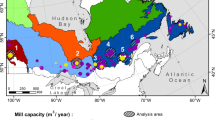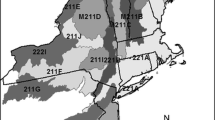Abstract
Boreal forests are exposed to periodic stand-replacing disturbances such as wildfire. Unchanging disturbance regimes in unmanaged forests result in an age-class structure in which the proportion of forest area is largest in the youngest age class and decreases exponentially in older age classes. The current (ca. 1970) age-class structure of Canadian forests contains a much smaller proportion of the forest area in each of the two youngest 20-yr age classes than in each of the next three age classes (i.e., the 40 to 99-yr age-classes). We hypothesize that more intensive disturbance regimes in the late 19th and early 20th centuries, compared to disturbances in the period 1920 to 1969, have resulted in this unusual age-class structure. The reduction in disturbance regimes has resulted in an increase of the average forest age and therefore an increase in total forest biomass carbon (C). This C sink is obtained without altering age-dependent growth or decomposition rates. If the average forest age of Canadian forests continues to increase, additional C sequestration of forests, (i.e., the C sink strength) will diminish. This result of a C sink in Canadian forest ecosystems is supported by more detailed C budget calculations for the year 1986.
Similar content being viewed by others
References
Alban, D.H. and D.A. Perala: 1992. Carbon storage in Lake States aspen ecosystems.Can. J. For. Res. 22: 1107–1110.
Apps, M.J.: 1993. NBIOME: a biome-level study of biospheric response and feedback to potential climate changes.World Resourc. Rev. (in press).
Apps, M.J. and W.A. Kurz: 1991. Assessing the role of Canadian forests and forest sector activities in the global carbon balance.World Resourc. Rev. 3: 333–344.
Apps, M.J. and W.A. Kurz: 1993. The role of Canadian forests in the global carbon budget. In:Carbon Balance of the World's Forested Ecosystems: Towards a Global Assessment, Publications of the Academy of Finland, in press.
Birdsey, R.A.: 1992. Carbon storage and accumulation on United States Forest Ecosystems. USDA For. Serv., Gen. Tech. Rep. WO-59, 51 pp.
Blais, J.R.: 1983. Trends in the frequency, extent, and severity of spruce budworm outbreaks in eastern Canada.Can. J. For. Res. 13: 539–547.
Boden, T.A., R.J. Sepanski, and F.W. Stoss, (eds): 1991. Trends '91: A Compendium of Data on Global Change. Carbon Dioxide Information Analysis Center, Oak Ridge National Laboratory, Oak Ridge, Tennessee, U.S.A., ORNL/CDIAC-46. 665 pp. and appendices.
Bonan, G.B., and H.H. Shugart: 1989. Environmental factors and ecological processes in boreal forests.Ann. Rev. Ecol. Syst. 20: 1–28.
Bonnor, G.M.: 1982. Canada's Forest Inventory 1981. Canadian Forestry Service, Environment Canada, Forestry Statistics and Systems Branch. 79 pp.
Bonnor, G.M.: 1985. Inventory of Forest Biomass in Canada. Canadian Forestry Service, Petawawa National Forestry Institute. 63 pp.
Cogbill, C.V.: 1985. Dynamics of the boreal forests of the Laurentian Highlands, Canada.Can. J. For. Res. 15: 252–261.
Cooper, C.F.: 1983. Carbon storage in managed forests.Can. J. For. Res. 13: 155–166.
Dellert, L.H.: 1991. What is British Columbia's timber supply forecast to the year 2050? In: Brand, D.G. (ed).Canada's Timber Resources, Forestry Canada, Petawawa National Forestry Institute, Chalk River, Ontario, Inf. Rep. PI-X-101. pp. 157–163.
Dewar, R.C.: 1991. Analytical model of carbon storage in the trees, soils, and wood products of managed forests.Tree Physiol. 8: 239–258.
Edmonds, J.: 1992. Why understanding the natural sinks and sources of CO2 is important: a policy analysis perspective.Water Air Soil Poll. 64: 11–21.
Forestry Canada: 1988. Canada's Forest Inventory 1986. Forestry Canada, Ottawa, Ont. 60 pp.
Hall, C.A.S. and J. Uhlig: 1991. Refining estimates of carbon released from tropical land-use change.Can. J. For. Res. 21: 118–131.
Harmon, M.E., W.K. Ferrell, and J.F. Franklin: 1990. Effects on carbon storage of conversion of old-growth forests to young forests.Science 247: 699–702.
Heath, L.S. and R.A. Birdsey: 1993. Carbon trends of productive temperate forests of the coterminous United States, this volume.
Honer, T.G., W.R. Clark, and S.L. Gray: 1991. Determining Canada's forest area and wood volume balance, 1977–1986. In: Brand, D.G. (ed).Canada's Timber Resources. Forestry Canada. Petawawa National Forestry Institute, Chalk River, Ontario, Inf. Rep. PI-X-101, pp. 17–25.
Houghton, R.A.: 1991. Tropical deforestation and atmospheric carbon dioxide.Climatic Change 19: 99–118.
Houghton, R.A., J.E. Hobbie, J.M. Melillo, B. Moore, B.J. Peterson, G.R. Shaves, and G.M. Woodwell: 1983. Changes in the carbon content of terrestrial biota and soils between 1860 and 1980: a net release of CO2 to the atmosphere.Ecol. Monogr. 53: 235–262.
Houghton, R.A., R.D. Boone, J.R. Fruci, J.E. Hobbie, J.M. Melillo, C.A. Palm, B.J. Peterson, C.R. Shaver, G.M. Woodwell, B. Moore, D.L. Skole, and N. Myers: 1987. The flux of carbon from terrestrial ecosystems to the atmosphere in 1980 due to changes in land use: geographic distribution of the global flux.Tellus B. 39: 122–139.
Johnson, E.A. and G.I. Fryer: 1987. Historical vegetation change in the Kananaskis Valley, Canadian Rockies.Can. J. Bot. 65: 853–858.
Kauppi, P.E., K. Mielikainen, and K. Kuusela: 1992. Biomass and carbon budget of European forests, 1971 to 1990.Science 256: 70–74.
Kurz, W.A. and M.J. Apps: (in prep.a). Estimation of root biomass and dynamics for the Carbon Budget Model of the Canadian forest sector. (manuscript in preparation).
Kurz, W.A. and M.J. Apps: (in prep.b). Canada's forests: a net carbon sink in 1986. (manuscript in preparation).
Kurz, W.A. and M.J. Apps: 1992. Atmospheric carbon and Pacific Northwest forests. In: Wall, G. (ed).Implications of Climate Change for Pacific Northwest Forest Management. Department of Geography, University of Waterloo, Waterloo, Ontario, Dept. of Geography Publ. Ser. Occassional Paper No. 15, pp. 69–80.
Kurz, W.A. and M.J. Apps: 1993. The carbon budget of Canadian forests: a sensitivity analysis of changes in disturbance regimes, growth rates, and decomposition rates.Environ. Poll. (in press).
Kurz, W.A., M.J. Apps, T.M. Webb, and P.J. McNamee: 1992. The Carbon Budget of the Canadian Forest Sector: Phase I. Forestry Canada, Northwest Region, Northern Forestry Centre, Edmonton, Alberta, Inf. Rep. NOR-X-326. 93 pp.
Kurz, W.A., M.J. Apps, B.J. Stocks, and W.J.A. Volney: 1993. Global climate change: disturbance regimes and biospheric feedbacks of temperate and boreal forests. In: Woodwell, G. (ed).Biotic Feedbacks in the Global Climate System: Will the Warming Speed the Warming? Oxford University Press, Oxford, UK, (cmin press).
Ontario Ministry of Natural Resources: 1992. Ontario Forest Products and Timber Resource Analysis. Volume I and Volume II — October 1992. Joint Study by: Resource Information Systems, Inc. Bedford, MA and Resource Economics, Inc. Corvallis, OR. Published by Ontario Ministry of Natural Resources, Sault Ste. Marie, Ontario. 139 pp.
Payette, S.: 1992. Fire as a controlling process in the North American boreal forest. In: Shugart, H.H., R. Leemans, and G.B. Bonan (eds),A Systems Analysis of the Global Boreal Forest, Cambridge: Cambridge University Press, pp. 144–169.
Quay, P.D., B. Tilbrook, and C.S. Wong: 1992. Oceanic uptake of fossil fuel CO2: Carbon-13 evidence.Science 256: 74–79.
Rastetter, E.B. and R.A. Houghton: 1992. Carbon budget estimates.Science 258: 382.
Rowe, J.S.: 1983. Concepts of fire effects on plant individuals and species. In: Wein, R.W. and D.A. MacLean (eds),The Role of Fire in Northern Circumpolar Ecosystems, SCOPE 18, Chichester: John Wiley & Sons, pp. 135–154.
Sedjo, R.A.: 1992. Temperate forest ecosystems in the global carbon cycle.Ambio 21 274–277.
Tans, P.P., I.Y. Fung, and T. Takahashi: 1990. Observational constraints on the global atmospheric CO2 budget.Science 247: 1431–1438.
Van Wagner, C.E.: 1978. Age-class distribution and the forest fire cycle.Can. J. For. Res. 8: 220–227.
Vinson, T.S. and T.P. Kolchugina: 1993. Pools and Fluxes of Biogenic Carbon in the Former Soviet Union, this volume.
Whynot, T.W. and M. Penner: 1990. Growth and yield of black spruce ecosystems in the Ontario Clay Belt: implications for forest management. Forestry Canada, Petawawa National Forestry Institute, Chalk River, Ontario, Inf. Rep. PI-X-99. 81 pp.
Wisniewski, J. and A.E. Lugo (eds): 1992. Natural Sinks of CO2, Kluwer Academic Publishers, Dordrecht, The Netherlands, 466 pp.
Yarie, J.: 1981. Forest fire cycles and life tables: a case study from interior Alaska.Can. J. For. Res. 11: 554–562.
Author information
Authors and Affiliations
Rights and permissions
About this article
Cite this article
Kurz, W.A., Apps, M.J. Conntribution of northern forests to the global C cycle: Canada as a case study. Water Air Soil Pollut 70, 163–176 (1993). https://doi.org/10.1007/BF01104994
Issue Date:
DOI: https://doi.org/10.1007/BF01104994




